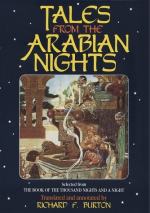[FN#30] Arab. “Ghashim,” see vol. ii. 330. It is a favourite word in Egypt extending to Badawiland, and especially in Cairo, where it is looked upon as slighting if not insulting.
[FN#31] The whole of the scene is a replica of the marriage between Kamar al-Zaman and that notable blackguard the Lady Budur (vol. iii. 211), where also we find the pigeon slaughtered (p. 289). I have mentioned that the blood of this bird is supposed throughout the East, where the use of the microscope is unknown, and the corpuscles are never studied, most to resemble the results of a bursten hymen, and that it is the most used to deceive the expert eyes of midwives and old matrons. See note to vol. iii. p. 289.
[FN#32] Scott (p. 254) makes his heroine “erect a most magnificent caravanserai, furnished with baths hot and cold, and every convenience for the weary traveller.” Compare this device with the public and royal banquet (p. 212) contrived by the slave-girl sultaness, the charming Zumurrud or Smaragdine in the tale of Ali Shar, vol. iv. 187.
[FN#33] In text “Shakhs,” see vol. iii. 26; viii. 159.
[FN#34] This assemblage of the dramatis personae at the end of the scene, highly artistic and equally improbably, reminds us of the ending of King Omar bin al-Nu’uman (vol. iii. 112)
[FN#35] The King and the Minister could not have recognised the portrait as neither had seen the original.
[FN#36] In text “Ishtalaka” = he surmised, discovered (a secret).
[FN#37] In the Arab. “she knew them,” but the careless storyteller forgets the first part of his own story.
[FN#38] Story-telling being servile work.
[FN#39] [In the Ms. “istanatu la-ha.” The translation in the text presupposes the reading “istanattu” as the 10th form of “matt) = he jumped, he leapt. I am inclined to take it for the 8th form of “sanat,” which according to Dozy stands in its 2nd form “sannat” for “sannat,” a transposition of the classical “nassat” = he listened to. The same word with the same meaning of “listening attentively,” recurs in the next line in the singular, applying to the captain and the following pronoun “la-ha” refers in both passages to “Hikayah,” tale, not to the lady-sultan who reveals herself only later, when she has concluded her narrative.—St.]
[FN#40] Here the converse is probably meant, as we have before seen.
[FN#41] Scott ends (p. 258) “Years of unusual happiness passed over the heads of the fortunate adventurers of this history, until death, the destroyer of all things, conducted them to a grave which must one day be the resting-place for ages of us all, till the receiving (?) angel shall sound his trumpet.”
[FN#42] Scott (vi. 259-267), “Story of Hyjuaje, the tyrannical Governor of Coufeh, and the Young Syed.” For the difference between the “Sayyid” (descendant of Hasan) and the “Sharif,” derived from Husayn, see vol. v. 259. Being of the Holy House the youth can truly deny tat he belongs to any place or race, as will be seen in the sequel.




